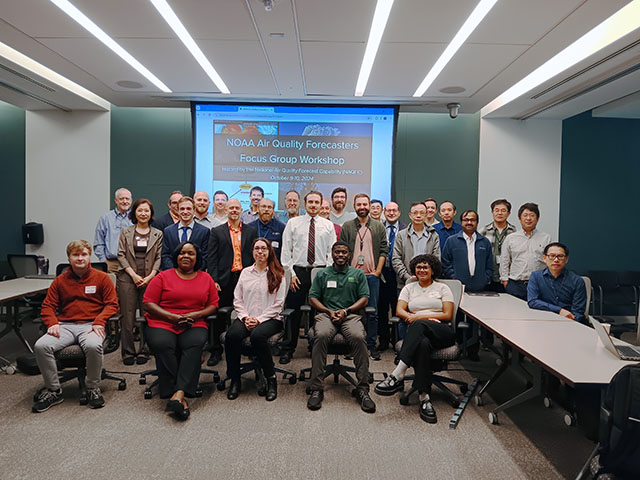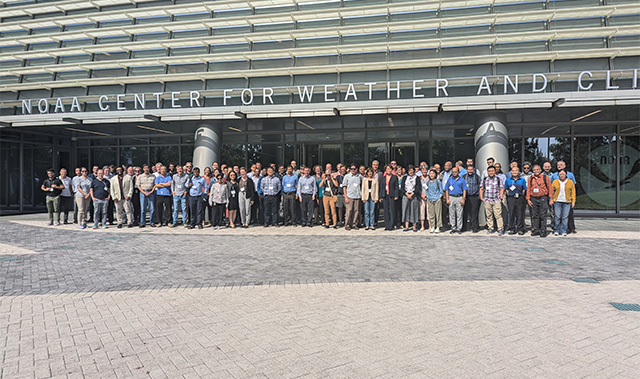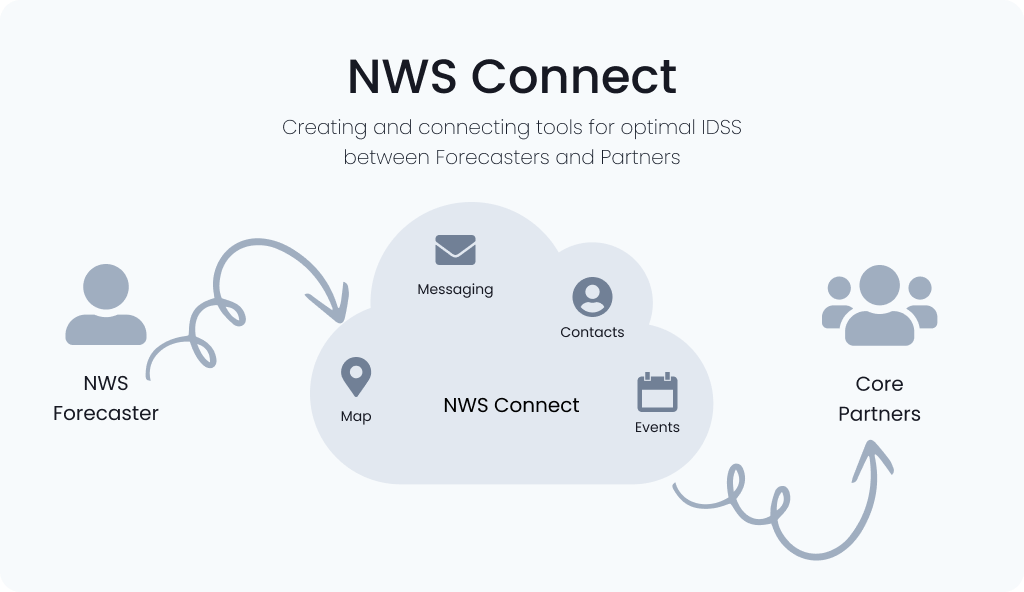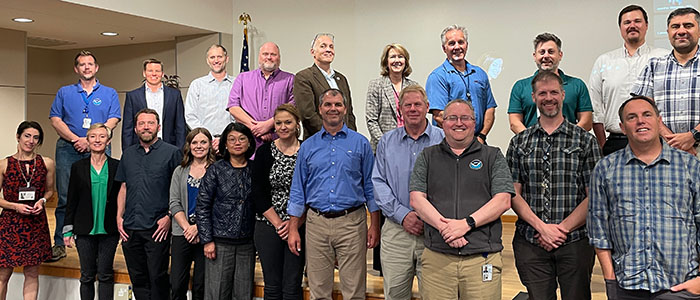Home - NWS OSTI
OSTI - Science and Technology Integration:
- Advance Operational Earth System Modeling
- Apply Social, Behavioral, and Economic Sciences to the NWS Mission
- Manage and accelerate the transition of research and development to NWS operations
- Develop cutting-edge tools and guidance to enhance NWS Service Delivery
News & Announcements
-

Nov 07, 2024
NOAA Air Quality Forecasters Focus Group Workshop - October 9-10, 2024
The National Oceanic and Atmospheric Administration National Weather Service (NOAA/NWS), under its air quality program, the National Air Quality Forecast Capability (NAQFC), hosted the annual Air Quality Forecasters’ Focus Group Workshop on October 9-10, 2024. -

Sep 30, 2024
The 2024 NOAA Subseasonal and Seasonal Applications Workshop - September 4-6, 2024
The 2024 NOAA Subseasonal and Seasonal Applications Workshop took place in College Park, MD at the NOAA Center for Climate and Weather Prediction (NCWCP) on September 4th-6th, 2024. The first iteration of this annual hybrid workshop hosted 330 registered participants (in-person and virtual) from the subseasonal-to-seasonal (S2S) research-to-operations (R2O), forecaster, and stakeholder communities across the globe and featured 87 oral presentations and 45 posters.... -

Aug 01, 2024
NWS Connect Initial Operating Capabilities Released
We are excited to announce the release of NWS Connect, marking the first iteration of many to come! NWS Connect is a vital element of Ken's 10 Probabilistic IDSS (Impact-based Decision Support Services) Initiative. This empowers NWS core partners, such as emergency personnel and public safety officials, to make informed decisions when weather, water, and climate events impact the lives and livelihood of the American people. -

Jul 31, 2024
OSTI Visits Colleagues in Boulder, CO
Honoring a commitment to conduct in-person meetings with the Oceanic and Atmospheric Research (OAR) Global Systems Laboratory (GSL), National Weather Service (NWS) Office of Science and Technology Integration (OSTI) representatives traveled to Boulder, Colorado the last week of May for two and a half days of familiarization meetings and strategic discussions with NWS and OAR offices and divisions in the local area.
OSTI Programs
The Office of Science and Technology Integration (STI) performs portfolio management for planning, research and development, and integration efforts for science and technology improvements across the NWS to build a Weather-Ready Nation. STI analyzes requirements for service improvements from NWS field offices and National Centers through close coordination with the AFS Office; develops potential scientific and technological solutions through coordination with partners within NOAA and with the external research community; and sponsors applied research and development of programs/projects to address these requirements.
Click on each hexagon to learn more about each program.
-
MDL
The Meteorological Development Laboratory (MDL) conducts and sponsors applied research and development for the improvement of diagnostic and prognostic weather information; data depiction and utilization; warning and forecast product preparation; and data and forecast evaluation. Projects involve modern physical, dynamical, and statistical techniques implemented on operational computers. Emphasis is placed on integrated suites of guidance and final products for Weather Forecast Offices, River Forecast Centers, and National Centers. The Laboratory collaborates with other laboratories and centers within and outside of NOAA and actively seeks to identify new techniques in response to NWS mission requirements. The Laboratory provides meteorological support to other elements of the Office of Science and Technology, as required.
-
OPG
The Operational Proving Ground (OPG) facilitates testing of advanced operations, services, and science and technology (S&T) capabilities which address the needs of both internal and external users. By creating a streamlined research-to-operations (R2O) and operations-to-research (O2R) process, an iterative, two-way interaction between S&T development and NWS operations is optimized. To be considered for operational implementation, candidate capabilities must successfully introduce a new or enhanced operational capacity with no appreciable negative impact on existing systems and practices. Particular emphasis is placed on applications which demonstrate substantive improvement to one or more of the following: the warning and forecast process, collaborative decision making, risk communication, and/or provision of impact-based decision support services.
-
R2O
The STI Field Driven Research to Operations (R2O) Team is responsible for coordination and management of NWS field-driven innovation and research to operations transition programs. The team works closely with the NWS regional Scientific Services Divisions (SSDs), Office of Water Prediction and NCEP service centers to organize and facilitate projects with Science and Operations Officers (SOOs) and Development and Operations Hydrologists (DOHs) to integrate new or improved science and technology into field operations. The team also provides programmatic support to major NWS R2O initiatives in several areas including aviation weather, lightning, fire weather, and climate.
-
STI Modeling
The STI Modeling Program Team is responsible for supporting a variety of NWS modeling and research initiatives to improve weather forecasts. This is accomplished by funding research and education projects to accelerate and advance the development of new models, and foster collaboration among NOAA research scientists, federal labs, operational forecasters and the academic community. Examples of programs managed by this program division include efforts to improve guidance for hurricane track, intensity, and storm surge forecasts; develop an end-to-end air quality forecast capability; advance research to extend forecast skill beyond 8-10 days; and implement a weather-scale, fully-coupled numerical weather prediction system.
-
VLab Cloud
VLab Cloud is a Cloud based system that supports research, development, testing, training, and non-mission critical workflows for the Office of Science and Technology Integration.
VLab Cloud goals are to:
- Maximizing stability and security while remaining agile
- Controlling and monitoring costs
- Providing security Responsive reliable support
- Streamline and automate onboarding and maintenance
-
SBES
The Social, Behavioral, and Economic Sciences (SBES) team works across the National Weather Service (NWS) to integrate social, behavioral and economic sciences into NWS products, information and services, with an aim toward improving the understanding and utility of NWS forecasts and warnings and transforming how the public receives, understands and ultimately acts on such information. As NWS fully embraces Impact-Based Decision Support Services (IDSS), NWS must use knowledge gained from social science research to better understand the relationship between environmental information and decision-making within the broader society.
-
STI Projects
NWS/OSTI supports competitive funding opportunities to the research community through the
following programs:- Collaborative Science, Technology, and Applied Research (CSTAR)
- Hurricane Forecast Improvement Program (HFIP)
- Next Generation Global Prediction System (NGGPS)
- Weeks 3-4 Program